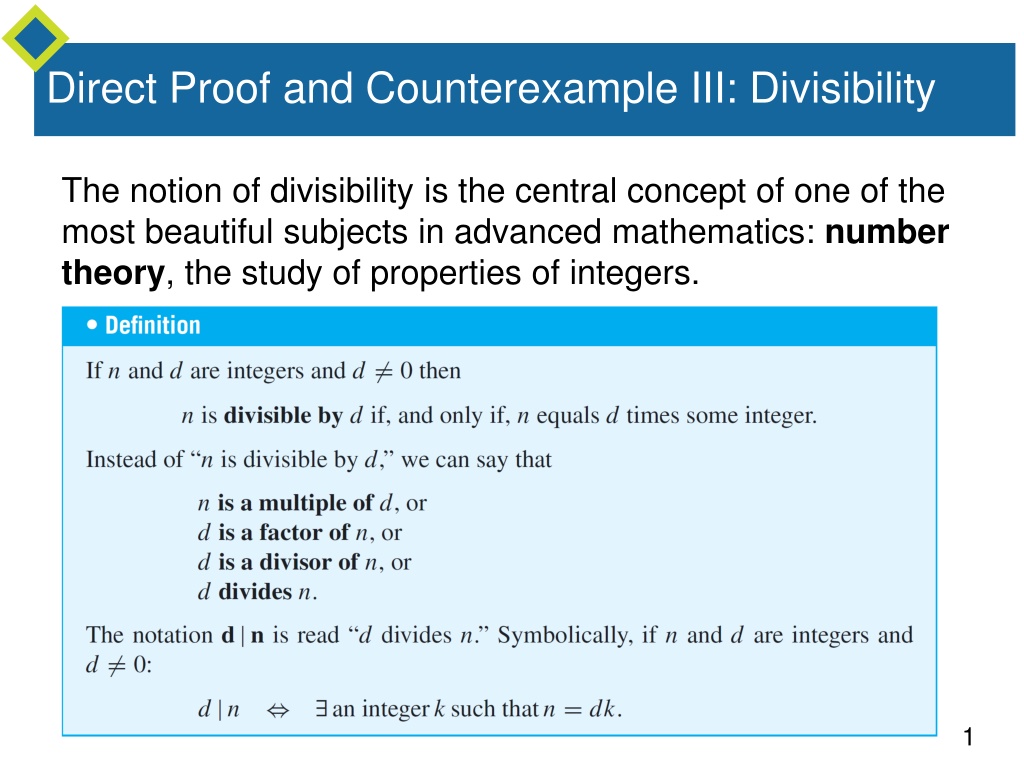Exploring Divisibility in Number Theory
Delve into the fascinating world of number theory, where the concept of divisibility plays a central role. Learn about the properties and applications of divisibility in integer mathematics through direct proofs, counterexamples, and algebraic expressions. Discover the transitivity of divisibility and useful properties that help in understanding relationships between positive integers.
Download Presentation

Please find below an Image/Link to download the presentation.
The content on the website is provided AS IS for your information and personal use only. It may not be sold, licensed, or shared on other websites without obtaining consent from the author. Download presentation by click this link. If you encounter any issues during the download, it is possible that the publisher has removed the file from their server.
E N D
Presentation Transcript
Direct Proof and Counterexample III: Divisibility The notion of divisibility is the central concept of one of the most beautiful subjects in advanced mathematics: number theory, the study of properties of integers. 1
Example 1 Divisibility a. Is 21 divisible by 3? Yes, 21 = 3 7. d. Is 32 a multiple of 16? Yes, 32 = ( 16) ( 2). b. Does 5 divide 40? Yes, 40 = 5 8. e. Is 6 a factor of 54? Yes, 54 = 6 9. c. Does 7|42? Yes, 42 = 7 6. f. Is 7 a factor of 7? Yes, 7 = 7 ( 1). 2
Example 1 Divisibility of Algebraic Expressions a. If a and b are integers, is 3a + 3b divisible by 3? b. If k and m are integers, is 10km divisible by 5? Solution: a. Yes. By the distributive law of algebra, 3a + 3b = 3(a + b) and a + b is an integer because it is a sum of two integers. b. Yes. By the associative law of algebra, 10km = 5 (2km) and 2km is an integer because it is a product of three integers. 3
Direct Proof and Counterexample III: Divisibility Two useful properties of divisibility are (1) that if one positive integer divides a second positive integer, then the first is less than or equal to the second, and (2) that the only divisors of 1 are 1 and 1. 4
Direct Proof and Counterexample III: Divisibility When the definition of divides is rewritten formally using the existential quantifier, the result is Since the negation of an existential statement is universal, it follows that d does not divide n (denoted ) if, and only if, integers k, n dk, or, in other words, the quotient n/d is not an integer. 5
Example 4 Checking Nondivisibility Does 4 | 15? Solution: No, , which is not an integer. 6
Example 6 Transitivity of Divisibility cont d Proof: Suppose a, b, and c are [particular but arbitrarily chosen] integers such that a divides b and b divides c. [We must show that a divides c.] By definition of divisibility, By substitution 7
Example 6 Solution cont d Let k = rs. Then k is an integer since it is a product of integers, and therefore Thus a divides c by definition of divisibility. [This is what was to be shown.] 8
Example 7 Checking a Proposed Divisibility Property Is the following statement true or false? For all integers a and b, if a | b and b | a then a = b. Solution: This statement is false. Can you think of a counterexample just by concentrating for a minute or so? By definition of divisibility, the conditions a | b and b | a mean that 9
Example 7 Solution cont d Must it follow that a = b, or can you find integers a and b that satisfy these equations for which a b? The equations imply that Since b | a, b 0, and so you can cancel b from the extreme left and right sides to obtain In other words, k and l are divisors of 1. But, the only divisors of 1 are 1 and 1. Thus k and l are both 1 or are both 1. 10
Example 7 Solution cont d But if k = l = 1, then b = a and so a b. This analysis suggests that you can find a counterexample by taking b = a. Here is a formal answer: 11
The Unique Factorization of Integers Theorem The most comprehensive statement about divisibility of integers is contained in the unique factorization of integers theorem. Because of its importance, this theorem is also called the fundamental theorem of arithmetic. The unique factorization of integers theorem says that any integer greater than 1 either is prime or can be written as a product of prime numbers in a way that is unique except, perhaps, for the order in which the primes are written. 12
The Unique Factorization of Integers Theorem Because of the unique factorization theorem, any integer n > 1 can be put into a standard factored form in which the prime factors are written in ascending order from left to right. 14
Example 9 Using Unique Factorization to Solve a Problem Suppose m is an integer such that Does 17 | m? Solution: Since 17 is one of the prime factors of the right-hand side of the equation, it is also a prime factor of the left-hand side (by the unique factorization of integers theorem). But 17 does not equal any prime factor of 8, 7, 6, 5, 4, 3, or 2 (because it is too large). Hence 17 must occur as one of the prime factors of m, and so 17 | m. 15




























